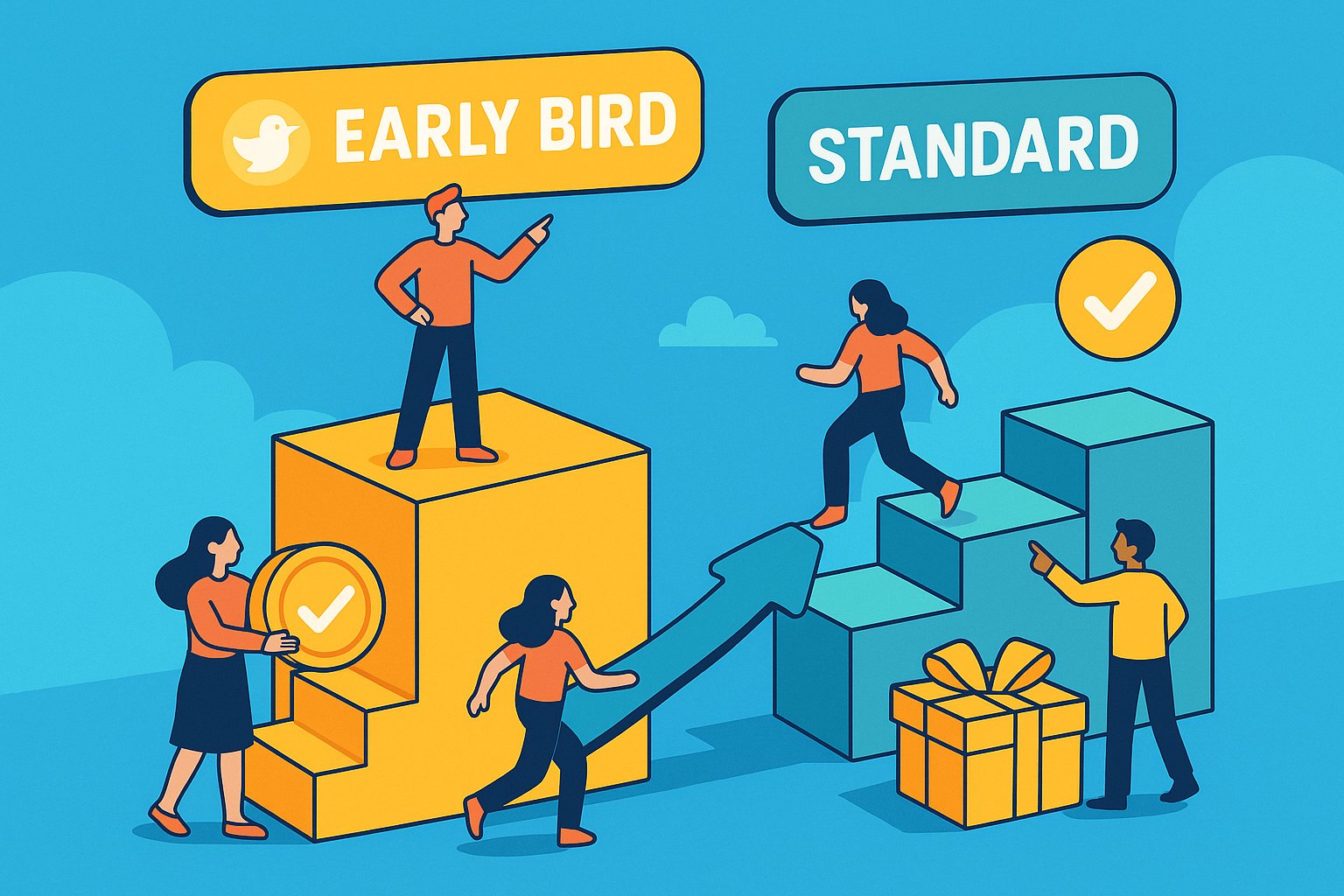The Importance of Strategic Perk Pricing
Pricing your campaign perks correctly is a nuanced art that can spell the difference between an underwhelming launch and a thriving, highly engaging crowdfunding success. At its core, perk pricing must do more than simply recover costs; it must speak to backers’ motivations, tap into their desire for value and exclusivity, and encourage them to take action right away. A well-priced perk signals both confidence in your product’s worth and respect for your backers’ investment. When you strike the right balance—offering tiers that range from affordable entry points to premium, limited-edition bundles—you create a ladder of engagement that draws supporters in at multiple levels.
In the first few days of a campaign, where momentum matters most, perk pricing can catalyze a surge of pledges that boosts visibility and inspires others to follow suit. Conversely, if your perks are priced too high, you risk alienating budget-conscious potential supporters. If they’re too low, you undermine perceived value and jeopardize your campaign’s financial viability. In this opening section, we’ll explore why pricing perks demands careful research, deep empathy for your audience, and a willingness to iterate. By viewing perk pricing as a dynamic strategy rather than a one-time decision, you position your campaign to maximize engagement, drive pledges across diverse backer personas, and set the stage for lasting community enthusiasm.
Tapping Into Backer Psychology
Understanding why people back a project in the first place is critical before you assign dollar values to your perks. Many supporters seek a sense of belonging—being among the first to own a cool gadget or wear a new design. Others are motivated by bargain opportunities, jumping at the chance to snag early-bird discounts or exclusive extras. Some backers derive satisfaction from aligning with a cause, so they look for perks that reflect meaningful impact or social recognition. When you assign prices, consider these underlying psychological drivers. A tier that offers a modest discount can feel like an immediate reward for acting quickly, while a higher-priced bundle that includes a personalized element—such as a handwritten thank-you note or co-creator credit—speaks to backers who want deeper involvement.
By segmenting backers into personas—early adopters, value seekers, community advocates—you can tailor perk prices to align with their priorities. Early adopters might tolerate a slightly higher price if they receive the product weeks ahead of retail. Value seekers might respond to mid-tier perks that bundle multiple items for a small premium. Community advocates might opt for top-tier packages that include behind-the-scenes access or the promise of ongoing updates. Embedding this psychological framework into your pricing decisions ensures that each perk resonates with a specific subset of your audience, fostering higher engagement and a sense of personal investment.
Balancing Cost Recovery with Perceived Value
Every perk you offer must begin with a meticulous cost analysis, accounting not just for production materials, but also for packaging, shipping (domestic and international), payment processing fees, and a cushion for unexpected expenses. For instance, if manufacturing a smart sensor costs $15 per unit and shipping averages $10 per package, you already have a $25 baseline before platform fees. Instead of simply marking up that cost by 100 percent to hit a $50 price point, evaluate how perceived value comes into play. If backers believe your smart sensor saves them time or solves a critical problem, they’re more likely to accept a $60 or $70 price tag—especially if you incorporate early-bird discounts for the first 100 backers.
Similarly, if your campaign includes a physical and a digital component—say, an illustrated handbook alongside the gadget—assign a higher perceived value to the combined offering rather than pricing each element independently. Packaging presentation, quality of printed materials, and the credibility established by professional photography all contribute to perceived worth. As you set prices, don’t shy away from transparent communication about these added values: a handcrafted wooden box or premium-quality printing serves as justification for a higher tier. Ultimately, balancing cost recovery with perceived value means refusing to see price as a mere number; it becomes a narrative of benefits, quality, and exclusivity—one that backers can readily grasp and support.
Crafting a Tiered Pricing Structure That Engages
A tiered pricing model offers backers options that range from low-cost entry points to premium, high-ticket experiences. At the base, consider an “Early Supporter” perk priced slightly below the later standard price—enough to reward action but still profitable. The next tier could include the core product at a competitive price paired with a minor add-on, like a sticker pack or digital wallpaper. A mid-tier package might combine multiple units or include exclusive design options—limited-edition colors or variant packaging that’ll never be available outside this campaign. At the top end, introduce a “Founders Circle” perk that grants backers direct input—perhaps a one-on-one video call with the creator or a spot on a virtual mastermind session.
As you define tier intervals, make sure the price gaps feel logical. If your second tier is $40 and your third is $65, backers need to perceive that the extra $25 unlocks tangible value: an added accessory, an extra month of support, or a branded case. Avoid confusing increments like $42 to $59, which appear arbitrary. Instead, opt for rounded figures such as $39, $59, and $99—each break signifying a step up in benefits. By building a tiered structure that layers psychological triggers—early-bird scarcity, bundle incentives, exclusive status—you create clear pathways for backers to select the tier that aligns with their budget and level of enthusiasm.
Introducing Time-Sensitive and Exclusive Incentives
Timing often matters as much as price. Early-bird perks drive that all-important initial surge, signaling to the crowd that your campaign is worth supporting. Consider allocating 15 percent of your total inventory to an “Early-Bird Starter” perk, in which the first 50 backers receive a $20 discount on the standard price. Once those slots vanish, make it clear that the cost will rise to the regular tier price. This scarcity-driven model spurs backers to pledge within hours of launch, amplifying momentum and enhancing discoverability on the platform’s algorithmic feeds.
After the early-bird phase, maintain excitement with mid-campaign flash deals or limited-run add-ons. For instance, for 48 hours only, offer a special bundle that includes a signed poster or downloadable celebratory song, ensuring that backers who missed the initial wave still feel they have a shot at something exclusive. Announce these time-sensitive incentives strategically—perhaps following a milestone achievement, like reaching 50 percent of the funding goal—to rekindle the community’s enthusiasm. By weaving time-sensitive pricing elements into your campaign, you accentuate urgency and maintain a sense of novelty that keeps backers engaged throughout the entire pledge window.
Testing and Iterating Pricing Strategies
No matter how much research you conduct in advance, some pricing assumptions only prove themselves once real backers engage. To test tier performance, consider offering limited slots at slightly varied prices. For example, list the standard product at $50 for the first 100 backers and then increase it to $55 for subsequent pledges. Monitor how quickly those first 100 slots sell out; if they deplete faster than expected, you may have underpriced the perk. Conversely, if they remain unclaimed for more than a day, you might need to adjust downward or enhance the value proposition—perhaps by bundling an extra digital guide.
Crowdfunding platforms often allow you to revise perk details mid-campaign, so remain agile. If analytics reveal that a particular tier is languishing, add a minor bonus—like expedited shipping or a commemorative digital badge—to boost its appeal. Conversely, if a mid-tier consistently outsells the entry tier, evaluate why the cheaper option underperforms: is the perceived value too low, or is the description unclear? By continuously tracking performance metrics—pledge velocity, average pledge amount, and tier conversion rates—you turn pricing into an iterative process, fine-tuning offerings in real-time to align with backer feedback and market signals. This adaptability underscores your commitment to delivering value and maximizes engagement over the entire campaign cycle.
Conveying Value Through Compelling Copy and Visuals
Once your perk prices and structures are in place, how you present them can sway undecided backers. Clear, persuasive copywriting anchors each tier’s rationale: instead of listing generic bullet points, craft short narratives that convey why a specific perk is worth its cost. For instance, a mid-tier description might read, “Unlock the perfect toolkit for on-the-go creators: our portable design kit arrives with straight-from-the-factory-quality materials, plus a custom-designed carry pouch, ensuring you’re ready to craft anywhere, anytime.” This vivid narrative paints a picture of use and utility rather than simply stating “includes pouch.”
Equally important are visuals. High-resolution images or 3D mock-ups showcase the product in lifestyle contexts—demonstrating how the perk fits into a backer’s daily life. If you offer a limited-edition color variant, provide side-by-side comparisons with standard versions, ensuring potential backers see exactly what sets it apart. Consider short, animated GIFs or brief video clips to highlight key features—such as a quick demonstration of a gadget in action—without requiring viewers to watch a full-length video. By combining evocative language with engaging visuals, you transform abstract prices into concrete benefits, helping backers understand why paying a particular amount makes sense for them.
Navigating Common Pricing Pitfalls
Even experienced creators can stumble when pricing perks. One common error is underpricing: setting a pledge amount so low that fulfillment costs outstrip revenue. If your break-even cost is $30 per unit, offering the same perk at $35 leaves no margin for unforeseen expenses like customs delays or expedited shipping. Conversely, overpricing can alienate your target audience; if most similar products retail at $70, asking for $100 without justifying the premium rarely convinces budget-conscious backers. Stay mindful of your competitors’ price points and be transparent about the costs and added values that warrant higher tiers.
Another pitfall is creating too many tiers, leading to decision paralysis. When presented with a dozen slightly different options—varying colors, sizes, add-ons—backers may hesitate, unsure which provides the best value. Keep your tier count manageable—ideally between five and eight—so each option stands out and feels distinct. Finally, don’t neglect to account for regional variations: international shipping complexities and local taxes can erode margins if unanticipated. Offering separate shipping add-ons or region-specific perk pages ensures that backers in Europe, Asia, or Australia see realistic prices rather than encountering unexpected fees at checkout. Anticipating and circumventing these common pitfalls maintains credibility and fosters a smoother engagement experience.
Turning Thoughtful Pricing into Backer Loyalty
Pricing your perks to maximize backer engagement requires more than spreadsheet calculations; it demands empathy for backer motivations, a willingness to iterate based on real-world feedback, and a narrative-rich presentation that underscores the value each tier holds. By tapping into psychological drivers—urgency, exclusivity, and community belonging—you craft perk structures that resonate on an emotional level. Balancing cost recovery with perceived value ensures that tiers remain sustainable and attractive, while tiered, time-sensitive, and limited-edition offers sustain campaign momentum from launch day to finale.
When you adopt a dynamic, data-informed approach—testing small price variations, monitoring performance, and refining perks—you demonstrate to backers that you are committed to their experience. This transparency breeds trust, encourages social sharing, and positions your campaign for viral traction. Ultimately, thoughtful pricing transforms one-time backers into long-term advocates, eager to share your vision and support future endeavors. As you embark on your next crowdfunding adventure, remember that every dollar you assign to a perk carries emotional weight; use that weight wisely to ignite engagement, foster loyalty, and drive your project toward lasting success.




